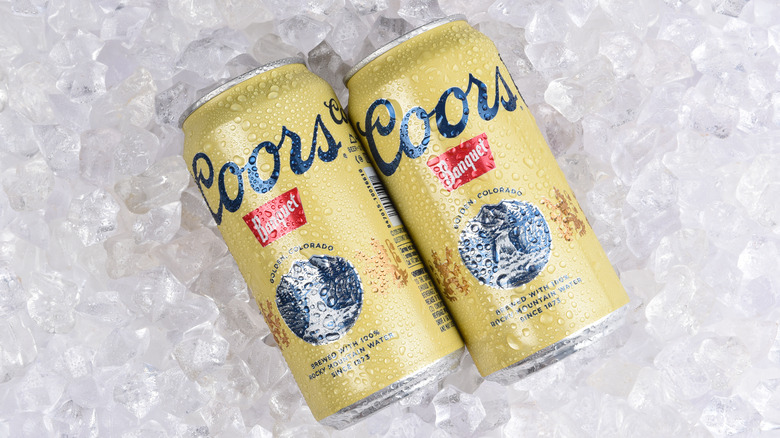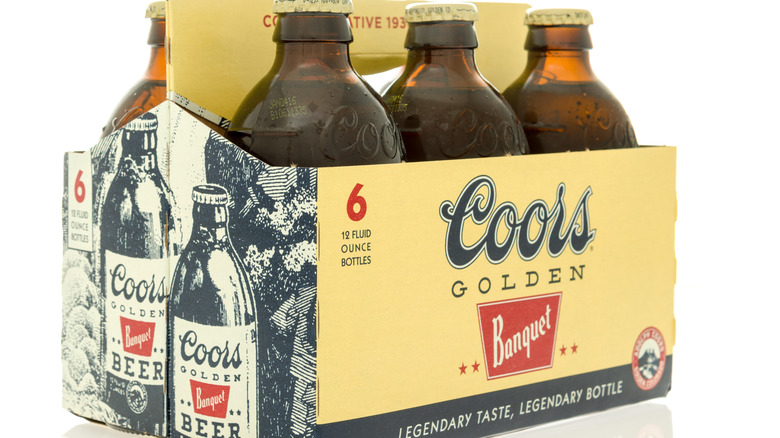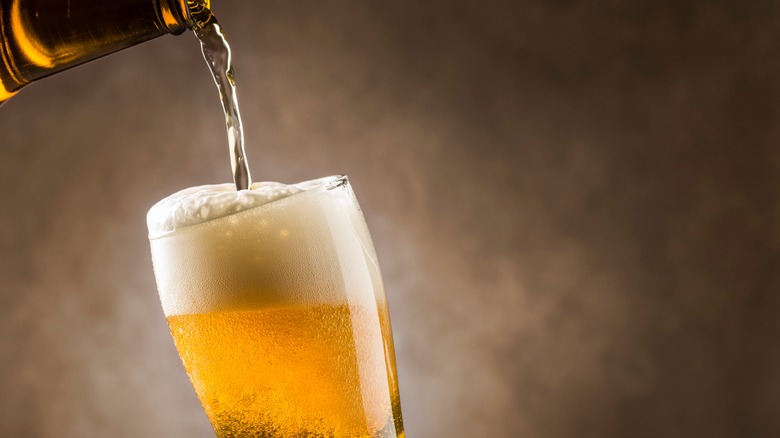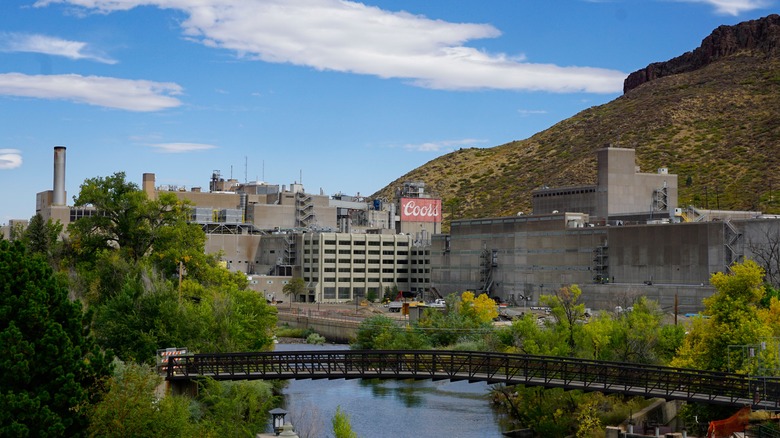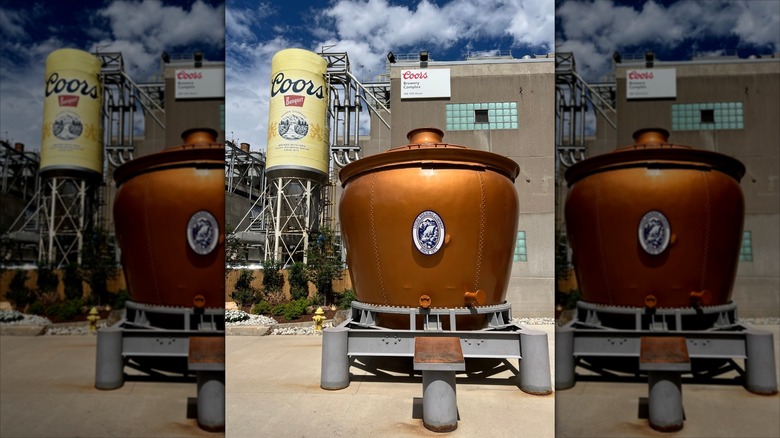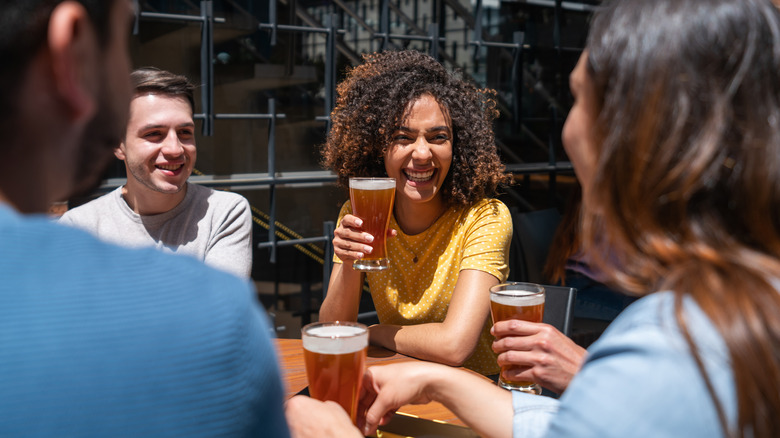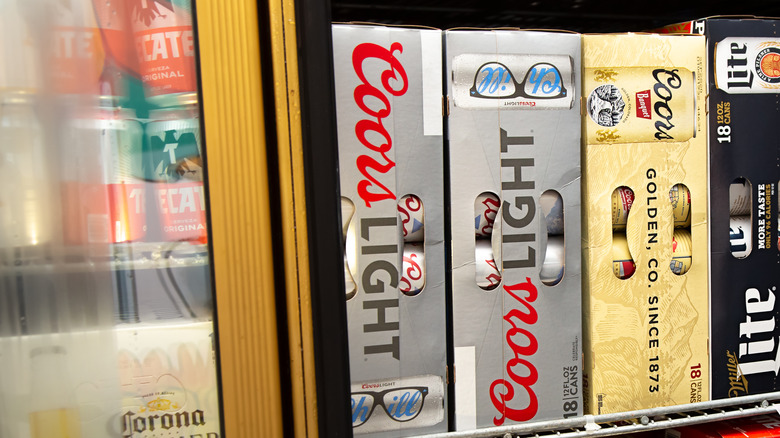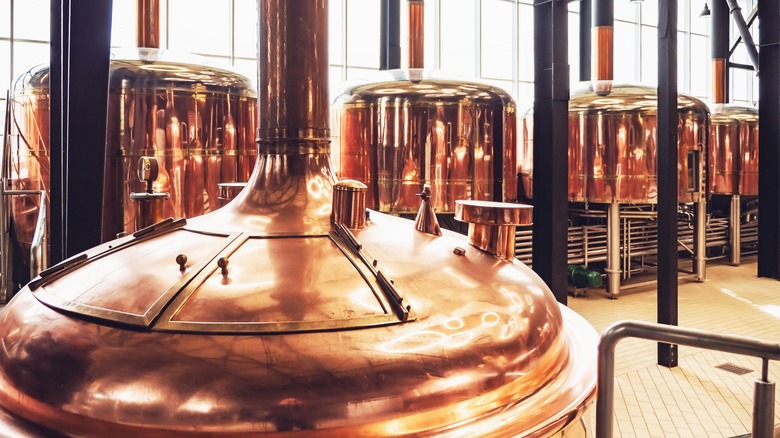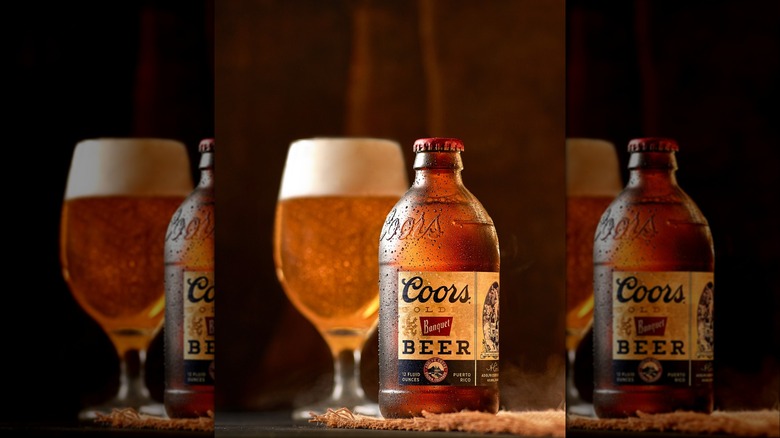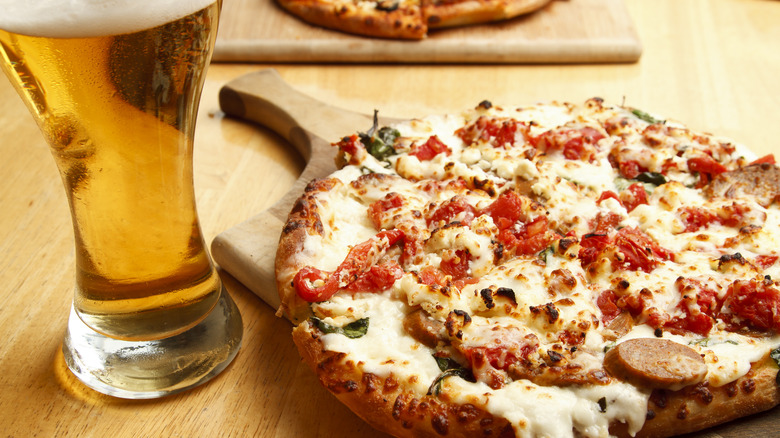All Your Questions About Coors Banquet Answered
Coors Banquet is a beer you might have seen around your entire life, but not know too much about. Less popular than Coors Light, there's often some confusion about what the other Coors offering is. But we're about to answer all your questions about Coors Banquet, from the basic to the more in-depth.
Despite being the comparatively less popular member of the Coors family, Banquet has been around for a long time. Maybe your grandmother drank it or perhaps it was the first beer you had a sip of. And, although it hasn't quite matched the popularity of Coors Light, its sales are increasing as people become more interested in brews with a deeper flavor.
Whatever you've been wondering about Coors Banquet — what type of beer it is, how long it's been around for, how it differs from Coors Light — we've got the answers for you. From its history to its tasting notes to what kind of food it pairs well with, there's so much to learn. Whether or not it's the drink for you, here's the score about Coors Banquet.
What type of beer is Coors Banquet?
First off, you might be wondering what type of beer Coors Banquet is. There are so many varieties of beer, each with their own flavor profiles and tasting notes. While some people will drink any beer on offer, others have strong preferences, so knowing what variety a beer is can help you understand whether or not you might like it. Of course, there's variation within each category — depending on factors like hop variety and brewing methods — but at least it gives you somewhere to start.
Coors Banquet is a lager, and more specifically, an American lager — similar to something like Budweiser or Miller. So, if you like these types of beers, you might enjoy Banquet. It's sometimes also referred to as golden lager, but this is because it's made in Golden, Colorado, rather than it being a particular style of beer.
The difference between a lager and an ale is down to the way they're brewed. However, the differences you'll notice as a consumer are in the flavor. Lagers are usually crisp with a lighter, cleaner flavor. Ales tend to be hoppier and more complex. However, there are a large number of ale varieties and they differ widely, from dark ales like stout to light ones such as IPA. American lager is known to be crisp with a particularly neutral flavor.
Is Coors Banquet the same as Coors Original?
Coors Banquet was first given its name in 1937, after prohibition, though the recipe had existed before then. Over the years, however, its name has changed several times and it has gone back and forth between Banquet and Original.
For instance, an ad back in 1988 talks about the name change from Banquet to Original Draft. It was then changed to Coors Original in 2002, before being renamed once again as Coors Banquet in 2007. So, it's natural that there's some confusion over the name and what it means.
Today, Coors Original is the name given to the version of Banquet that's brewed in Canada. It's made using the same recipe but not the same Rocky Mountain water that true Banquet is brewed with. Although you'd expect the same results, some buyers say this makes all the difference and Original is inferior to Banquet. So, if you want that true taste of the Rockies, Banquet is the way to go — leave Original on the shelf.
How long has Coors Banquet been around for?
Coors Banquet has been a staple on the American beer scene for more than a lifetime. The beer was first brewed back in 1873, by Adolph Coors, who came to America from Germany. The name "Coors Banquet" was first adopted in 1937, emerging in the wake of Prohibition as the company sought to evoke a sense of celebration and abundance. It was a nod to the miners who originally drank the beer, enjoying it with hearty feasts at the end of a hard working day.
Over the decades, this lager has earned its place in the hearts of beer lovers across generations. In fact, Coors Banquet even plays a pivotal role in one of the most beloved smuggling plots in film history — "Smokey and the Bandit." In that classic 1977 road movie, the characters wanted to drink Coors Banquet at a truck show so badly that they risked smuggling it, even though at that time it was illegal to sell it east of the Mississippi River.
Fast forward to recent years, and Coors Banquet continues to honor its past with modern twists. In 2021, the brand launched a "Smokey and the Bandit" themed mobile scavenger hunt. So, although the beer has existed for more than 150 years, it still manages to have cultural relevance.
Where is Coors Banquet brewed?
There are some secrets beer companies don't want you to know, but Coors is proud of where it comes from. In fact, it's part of its selling point. Coors Banquet is brewed in the heart of the Rocky Mountains — in Golden, Colorado — a detail that's central to its identity. It's a big part of the Coors brand and we understand why.
This iconic lager has been produced in Golden since the early days of the brewery in the 1870s. It's here, amid the crisp mountain air and pristine Rocky Mountain water, that Coors Banquet is given life. It's that water that sets it apart from other American lagers. While there's a Canadian version of Banquet called Coors Original, true aficionados know that nothing compares to the genuine article brewed in Golden.
In order to have the Banquet name, it has to come from the Coors brewery in Golden. Other Coors beers are made in various factories across the world, but not Banquet. That's why you can't find it in most other countries, even in ones where you'd be able to pick up a Coors Light.
What are the ingredients in Coors Banquet?
Coors Banquet is crafted from a handful of ingredients: water, barley, corn syrup, hops extracts, and yeast. These are fairly simple ingredients, but that's the way it is with beer. Each one plays a role in the overall flavor.
Let's start with water. In any beer, water is the foundation. The water used in Coors Banquet is prized for its purity and mineral content. It's part of what gives it that crisp, refreshing taste. Next up is barley, which is an important part of the brewing process. Barley provides the malt that converts into sugars. These sugars are essential. They're the fuel for fermentation, and without fermenting, beer wouldn't be alcoholic. Barley also imparts a natural sweetness and a toasty flavor. Then there's corn syrup, an adjunct that's added to boost the fermentable sugars without overwhelming the beer's flavor. It helps lighten the body of the beer so it has a smoother, crisper finish that's characteristic of an American lager like Coors Banquet.
Hops extracts help balance the sweetness of the malt. Hops are responsible for the bitterness that cuts through the flavor and can provide nuanced flavor notes. Lagers like Banquet aren't heavy on hops but they still play an important part. Finally, yeast is what transforms all those sugars into alcohol and carbon dioxide. The fermentation process is powered by yeast, developing the alcohol content and carbonation of the beer.
What gives Coors Banquet its distinctive flavor?
A lot of beers are made using the same or similar ingredients, so what gives Coors Banquet its distinctive flavor? Why doesn't it taste just the same as a Budweiser or a Pabst Blue Ribbon? There are several factors that go into these differences.
First off, there's the water, which we've already discussed. It's a big part of the true Banquet flavor, which we know because Coors Original, made in Canada with an identical recipe but different water, doesn't taste the same. Other ingredients, like the types of hops and barley also play a part in the overall flavor.
But aside from what's in the beer, the process matters too. Coors Banquet is brewed using a technique called closed horizontal box fermentation. In short, it means the beer is brewed at low temperatures. It results in the slight banana-like flavor you might have noticed in Banquet beer.
Coors also uses a particular filtration method when making Banquet. It opts for Enzinger filters, which are German mechanical filters, using metal plates and paper leaves. They filter beer slower than some other techniques, but they add to the character of the finished drink.
What's the ABV of Coors Banquet?
You might be wondering how strong this beer is, whether that's because you like a robust lager or you prefer something lighter. Well, the ABV, or Alcohol By Volume, of Coors Banquet is 5%, which is about average for a beer of its type, though you can find both weaker and stronger lagers.
ABV measures the percentage of alcohol present in a beverage. In beer, it indicates how much of the total volume is pure alcohol, helping drinkers gauge the strength of the brew. A beer with 5% ABV contains 5% alcohol and 95% other ingredients like water, malt, and hops. A standardized method for measuring alcohol in beer not only lets drinkers understand how buzzed it might get them, but also lets brewers maintain consistency across batches.
If you're a fan of international beers, you might notice that American lagers often have a lower alcohol content. The reason for this mostly comes down to consumer preference. Although the American beer market is changing, many drinkers in the U.S. have traditionally preferred the light, crisp, refreshing flavor of a moderate to low alcohol lager, versus the heavier flavor of higher alcohol beers.
What's the difference between Coors Banquet and Coors Light?
Many people get Coors Banquet and Coors Light confused. Some even think they're the same thing or that the beer is called Coors Light Banquet. But the Truth behind Coors beer is that these are two totally different drinks. So, how do they vary from one another?
Coors Banquet is a heartier, more full-bodied brew with a golden color. Its taste is rich and robust, with a subtle sweetness. Its 5% alcohol content gives it a creamier mouthfeel, though it's still quite thin if you're used to stronger beers. It's more of a complex choice than the Light version, focusing more on complexity of flavor than simply being refreshing.
Coors Light has a straw-golden or amber tone and a refreshingly crisp profile. It's designed to have a wide appeal. With an ABV of 4.2%, Coors Light is less about rich flavor and more about being an easy-drinking, refreshing choice. It's an ideal partner for grilling sessions, spicy appetizers, and light meals. Its thin, almost watery texture and minimal aftertaste is great for anyone who wants a refreshing drink above all else.
In short, if you tend to like the original versions of Budweiser or Miller, you'll probably like Banquet. But, should you prefer Bud Light or Miller Light, you should reach for the Coors Light.
What are the tasting notes of Coors Banquet?
Tasting notes are a way to describe the flavors of a beer, so you know what to expect with each sip. It may seem a little pretentious to talk about tasting notes in regards to a basic American lager like this one, but it can help you decide whether or not you might like it.
With Coors Banquet, you'll notice a mild sweetness paired with the robust flavor of barley. It has notes of corn and grains. This base is gently offset by slight bitterness from the hops and yeast, which makes the beer refreshing and light, though still heavier than a light beer.
The aroma is inviting, carrying hints of freshly baked bread along with a bit of creamed corn. There's also a slight fruitiness, with notes of pear and banana to the scent that can carry through into the flavor, too, albeit subtly.
Is Coors Banquet a craft beer?
Coors Banquet might have been around a long time, but it certainly isn't a craft beer. Perhaps when it was first brewed way back in the 1800s, it could have been considered so, but today it's a mainstream lager. Craft beer is produced by small, independent breweries that put a lot of effort into the flavors, quality, and overall experience of their brews. Craft brewers tend to experiment with different ingredients and techniques to create beers that stand out in character, flavor, and overall quality. These breweries often focus on a hands-on approach, valuing creativity and a personal touch over mass production.
Coors Banquet, however, is produced by the Molson Coors Beverage Company, a huge conglomerate that produces Coors beer, alongside a range of other mainstream beers, such as Fosters, Grolsch, and Madri. Although Banquet is made from an old recipe, you couldn't say there's the same level of care put into its production as you'd find at a small, independent craft brewery.
However, craft beer isn't for everyone. Even the great Anthony Bourdain wasn't a fan of craft beer. If you prefer a simple mass-produced American larger over a New England IPA from a small East Coast brewery, that's okay. Some people will always prefer the familiarity of a mainstream lager, so just because it isn't a craft beer, that doesn't mean you should avoid it if you like the way it tastes.
Is Coors Banquet popular?
You might be wondering whether or not Coors Banquet is a popular beer. Well, it might not be among the most popular beers in America, but it is growing in popularity. Of course, it doesn't matter how popular or unpopular a drink is, as long as you like it.
Coors Light is in the top five most popular beers in the U.S., ranking at number 4. Banquet, on the other hand, hasn't even made the top 10. While Coors Banquet may not reach the same level of mainstream popularity as Coors Light, it has a dedicated following and its sales are growing.
Over the last few years, it has grown in popularity every year. In 2023, its sales were up 28% on the year before. Interestingly, Coors Banquet experienced a resurgence in sales after being featured in Netflix series' like "Cobra Kai" and "Stranger Things." This pop culture exposure introduced the beer to a new generation of viewers. But it also has a vintage appeal, showing up in old photos of stars like Marilyn Monroe and Keith Richards, so there's something cool and timeless about it.
Regionally, Coors Banquet has been particularly popular in the Midwest and Rocky Mountain areas, aligning with its historical roots in Colorado. It was once only available in and around Colorado. It only became available nationwide in 1991, so the rest of the U.S. had some catching up to do.
What foods pair well with Coors Banquet?
The name Banquet conjures up images of food, so perhaps you'd like to know what pairs well with it. As an easy-drinking beer it's fairly versatile, but it still works better with some meals than others.
Lagers in general pair well with robust foods, including fried foods like wings, fries and tots. They're great with grilled foods, so Coors Banquet is a good beer to pick up when you're heading to a cookout. It's got enough body to hold its own but it isn't going to fight against any strong flavors, instead it's going to be refreshing and cleanse your palate.
Other good food pairings include pizza, cheese, oily fish, and desserts. You can't go too far wrong when pairing Coors Banquet with food. Stay away from anything extremely gourmet, as the contrast might feel a bit odd. It can also overwhelm simple fare.
